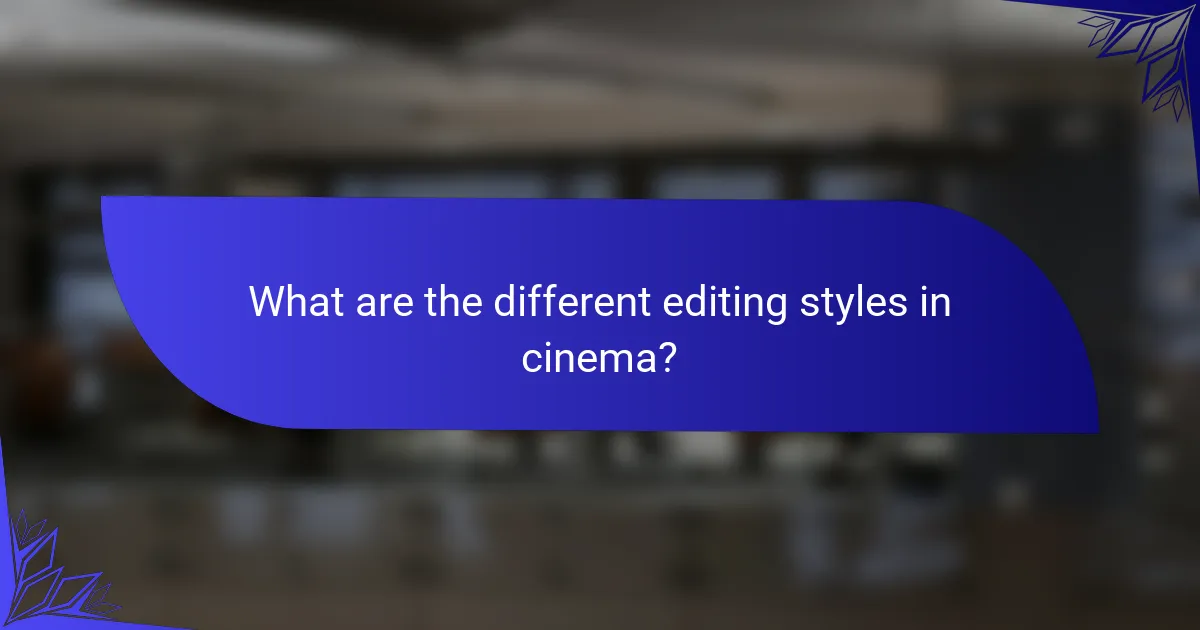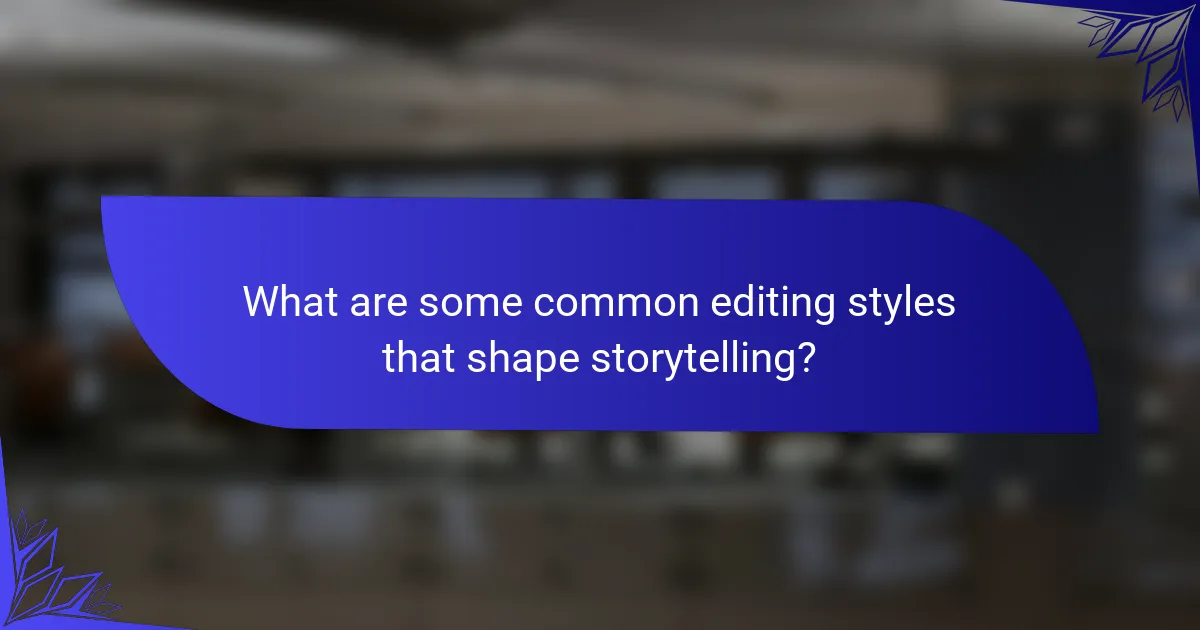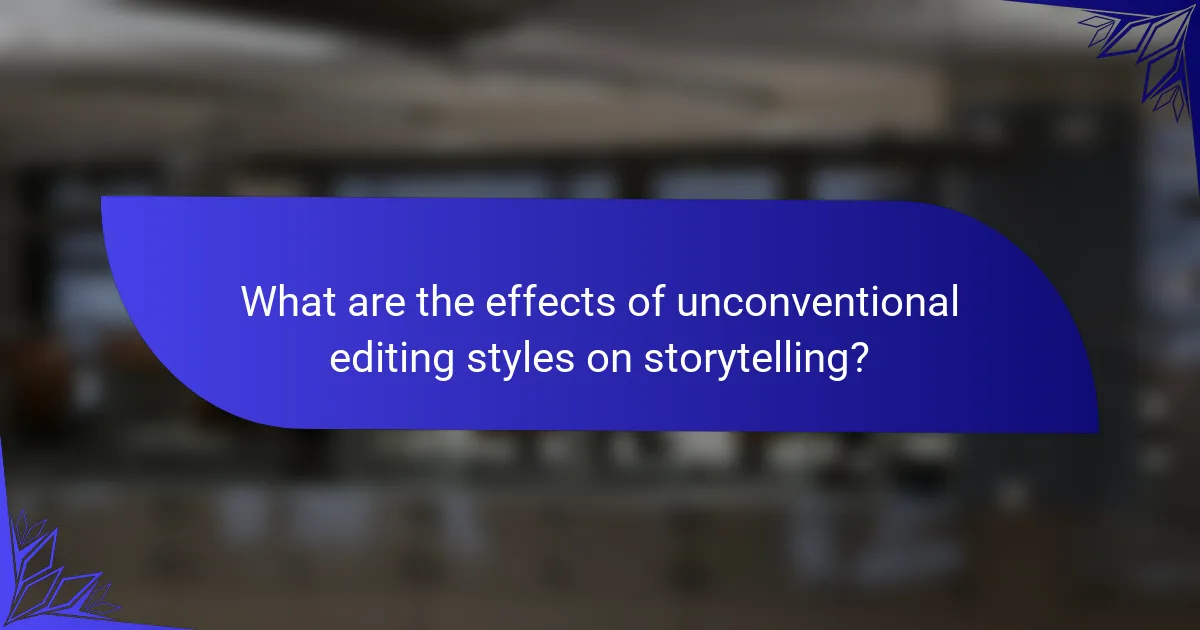Editing styles in cinema, including continuity editing, montage editing, and non-linear editing, play a crucial role in shaping storytelling. Continuity editing ensures a seamless flow of action and consistency in time and space, facilitating audience engagement. Montage editing juxtaposes contrasting images to create meaning and emphasizes thematic elements, while non-linear editing disrupts chronological order to build suspense and deepen character motivations. Each style has distinct historical roots and applications, influencing viewer perception and emotional engagement, as exemplified by films like “Psycho,” “Pulp Fiction,” and “Eternal Sunshine of the Spotless Mind.” Understanding these editing techniques is essential for appreciating their impact on narrative structure and audience experience in cinema.

What are the different editing styles in cinema?
The different editing styles in cinema include continuity editing, montage, and non-linear editing. Continuity editing maintains a seamless flow between shots. It focuses on ensuring that time and space are consistent, helping the audience follow the narrative. Montage editing juxtaposes disparate images to create meaning. This style often condenses time and emphasizes thematic elements. Non-linear editing disrupts chronological order. It presents events out of sequence to create suspense or reveal character motivations. Each style serves specific storytelling purposes and impacts audience perception. For example, Alfred Hitchcock’s “Psycho” uses non-linear editing to enhance suspense and surprise.
How do editing styles influence storytelling in films?
Editing styles significantly influence storytelling in films by shaping the narrative structure and emotional impact. Different editing techniques can create tension, pace, and rhythm. For instance, quick cuts can heighten excitement, while longer takes can build suspense. The choice of transitions, like fades or wipes, can signify changes in time or perspective. Editing also controls the flow of information, revealing or withholding details to guide audience perception. A study by Bordwell and Thompson in “Film Art: An Introduction” highlights how editing affects viewer engagement and comprehension. Effective editing aligns with the film’s genre, enhancing the overall storytelling experience.
What are the key techniques used in various editing styles?
Key techniques used in various editing styles include continuity editing, montage, and jump cuts. Continuity editing maintains a seamless flow of action. It ensures spatial and temporal coherence in storytelling. This technique often uses shot-reverse-shot sequences for dialogue. Montage compresses time and conveys information quickly. It juxtaposes images to create meaning. Jump cuts create a sense of urgency or disorientation. They disrupt the continuity for artistic effect. Each technique serves specific narrative purposes in cinema.
How do these techniques alter the viewer’s perception of the narrative?
Editing techniques significantly alter the viewer’s perception of the narrative. Techniques such as jump cuts, cross-cutting, and montage create different emotional responses. Jump cuts can disrupt the flow, leading to a sense of urgency or confusion. Cross-cutting builds tension by juxtaposing simultaneous actions. Montage compresses time, allowing viewers to grasp complex ideas quickly. Each technique influences how viewers interpret character motivations and plot developments. For example, a rapid series of cuts may suggest chaos or excitement, while longer takes can evoke contemplation. These alterations guide audience engagement and understanding of the story’s themes.
Why is editing considered a crucial element of filmmaking?
Editing is considered a crucial element of filmmaking because it shapes the narrative and pacing of a film. It allows filmmakers to control the flow of the story. Through editing, scenes can be juxtaposed to create tension or emotion. The rhythm of the cuts can influence audience engagement. Effective editing enhances storytelling by ensuring clarity and coherence. It can also manipulate time, allowing flashbacks or slow motion. Historical examples, such as the rapid cuts in “Psycho,” demonstrate how editing can heighten suspense. Thus, editing is essential for crafting a compelling cinematic experience.
What role does editing play in pacing and rhythm?
Editing significantly influences pacing and rhythm in film. It determines how quickly or slowly a story unfolds. Editors control the duration of shots and the sequence in which they appear. This control affects the audience’s emotional engagement. Quick cuts can create tension or excitement. Conversely, longer takes may evoke contemplation or sadness. The rhythm established by editing guides viewer reactions. For example, in action films, rapid editing heightens adrenaline. In contrast, dramas often utilize slower pacing to deepen character development. Thus, editing is crucial for shaping the overall narrative experience.
How does editing affect character development and emotional impact?
Editing significantly influences character development and emotional impact in cinema. It shapes how audiences perceive characters through pacing, transitions, and scene selection. For instance, rapid cuts can create tension and urgency, enhancing emotional responses. Conversely, longer takes allow for deeper character exploration and emotional resonance. Editing also controls the narrative flow, guiding viewer empathy. By juxtaposing scenes, editors can highlight character contrasts, revealing motivations and growth. Research shows that editing styles directly affect audience engagement and emotional connection to characters. A study by Bordwell and Thompson in “Film Art: An Introduction” emphasizes that editing is crucial in shaping narrative meaning and emotional depth.

What are some common editing styles that shape storytelling?
Common editing styles that shape storytelling include continuity editing, montage editing, and non-linear editing.
Continuity editing maintains a seamless flow of action, ensuring spatial and temporal coherence. This style helps audiences follow the narrative easily. Montage editing juxtaposes disparate images to create meaning through contrast. It often condenses time and highlights thematic connections. Non-linear editing disrupts chronological order, allowing for complex narrative structures. This style can evoke emotions and create suspense by revealing information out of sequence.
These editing styles have been foundational in cinema. For instance, continuity editing has roots in early Hollywood films, ensuring viewer engagement. Montage editing gained prominence in Soviet cinema, particularly through filmmakers like Sergei Eisenstein. Non-linear narratives have been effectively utilized in films such as “Pulp Fiction,” showcasing the versatility of storytelling through editing.
How does continuity editing create a seamless narrative flow?
Continuity editing creates a seamless narrative flow by ensuring spatial and temporal consistency in a film. It maintains the illusion of reality by aligning actions, positions, and movements across cuts. This technique uses the 180-degree rule to preserve screen direction, allowing viewers to follow characters easily. Additionally, match cuts link similar actions or objects, reinforcing the narrative connection. Eyeline matches help establish character perspectives, guiding audience attention. These practices collectively minimize distractions, keeping viewers engaged with the story. Studies show that effective continuity editing enhances viewer comprehension and emotional involvement.
What are the principles behind continuity editing?
Continuity editing aims to create a seamless flow of action in film. It ensures that the narrative remains coherent and logical for the audience. Key principles include the 180-degree rule, which maintains spatial relationships between characters. Another principle is match on action, where an action is continued across cuts. Eyeline matches are also crucial; they show where a character is looking. Shot/reverse shot techniques help depict conversations effectively. Consistent lighting and sound design further enhance continuity. These principles collectively support viewer immersion and understanding of the story.
How does continuity editing enhance audience engagement?
Continuity editing enhances audience engagement by creating a seamless flow of action and narrative. This editing style maintains spatial and temporal consistency, allowing viewers to easily follow the story. By ensuring that cuts are smooth and logical, continuity editing minimizes distractions. It keeps the audience immersed in the film’s world, fostering emotional connections with characters. Research indicates that effective continuity editing can increase viewer comprehension and retention of the plot. A study by Bordwell and Thompson in “Film Art: An Introduction” highlights how this technique supports narrative clarity. Consequently, audiences are more likely to remain engaged and invested in the storyline.
What is the significance of montage editing in storytelling?
Montage editing significantly enhances storytelling by condensing time and space. It allows filmmakers to juxtapose images, creating meaning through the contrast and connection of scenes. This technique can evoke emotions, establish themes, and provide context rapidly. For instance, in Sergei Eisenstein’s films, montage was used to convey complex ideas and social commentary. The famous “Odessa Steps” sequence demonstrates how montage can heighten tension and drama. By combining shots, filmmakers can manipulate audience perception and engagement. Overall, montage editing serves as a powerful tool in visual storytelling, shaping how narratives unfold.
How does montage editing convey complex ideas or emotions?
Montage editing conveys complex ideas or emotions by juxtaposing images to create meaning. This technique allows filmmakers to compress time and convey narrative efficiently. By placing contrasting or complementary scenes together, it evokes emotional responses from the audience. For example, Eisenstein’s use of montage in “Battleship Potemkin” illustrates conflict and tension through rapid cuts. The iconic Odessa Steps sequence employs fast-paced editing to heighten the sense of chaos and urgency. This method effectively communicates complex themes without lengthy exposition. Montage can also suggest relationships between characters or events, deepening the viewer’s understanding. Overall, it transforms visual storytelling into a powerful emotional experience.
What are examples of effective montage sequences in film?
Effective montage sequences in film include the training montage in “Rocky.” This sequence shows Rocky Balboa’s preparation for a boxing match. It highlights his physical transformation and determination. Another example is the opening montage of “Up.” This sequence conveys a lifetime of love and loss in just a few minutes. It effectively establishes character and emotional depth. The “Godfather” wedding montage also stands out. It juxtaposes a wedding celebration with violent undertones. This contrast enhances the film’s themes of family and power. Each of these sequences uses rapid editing to convey complex narratives efficiently.

What are the effects of unconventional editing styles on storytelling?
Unconventional editing styles significantly alter storytelling by creating unique narrative structures. These styles can disrupt traditional linear progression, allowing for non-linear timelines. This approach can enhance emotional engagement by juxtaposing contrasting scenes. It can also challenge viewer perceptions and interpretations of the story. For instance, films like “Eternal Sunshine of the Spotless Mind” use fragmented editing to reflect the protagonist’s memory. This technique deepens the audience’s connection to the character’s emotional state. Additionally, unconventional editing can introduce surreal elements, altering the viewer’s reality. Overall, these effects contribute to a more immersive and thought-provoking cinematic experience.
How does jump cut editing impact narrative structure?
Jump cut editing significantly alters narrative structure by creating a disjointed flow of time and space. This technique allows filmmakers to condense time, eliminating unnecessary scenes. As a result, the pacing of the narrative can become faster and more dynamic. Jump cuts can also create a sense of urgency or tension, engaging the audience more effectively.
Historical examples include films like “Breathless” by Jean-Luc Godard, which used jump cuts to reflect the protagonist’s chaotic life. This method can also invite viewers to fill in narrative gaps, fostering deeper engagement with the story. Overall, jump cut editing reshapes how audiences perceive continuity and character development within a film’s narrative.
What are the creative uses of jump cuts in modern cinema?
Jump cuts are a film editing technique that allows for the omission of time between scenes. They are creatively used to create a sense of urgency. This technique can heighten emotional impact in a narrative. Jump cuts can also emphasize character development by showing changes over time. Additionally, they can introduce humor by creating unexpected transitions. In modern cinema, filmmakers like Edgar Wright effectively use jump cuts for comedic timing. Films such as “Scott Pilgrim vs. The World” showcase this technique to enhance storytelling. The use of jump cuts can also convey disorientation or chaos, as seen in “Requiem for a Dream.” Overall, jump cuts serve various narrative purposes that contribute to the overall cinematic experience.
How do jump cuts influence audience interpretation?
Jump cuts influence audience interpretation by creating a sense of disorientation and urgency. This editing technique disrupts the continuity of time and space. As a result, viewers may feel a heightened emotional response. Jump cuts can also emphasize key moments by drawing attention to specific actions or dialogue. They challenge traditional storytelling by presenting fragmented narratives. This fragmentation can lead to various interpretations of character motivations. Studies show that jump cuts can enhance engagement by maintaining viewer interest. For example, films like “Breathless” use jump cuts to establish a unique narrative style.
What is the role of non-linear editing in storytelling?
Non-linear editing plays a crucial role in storytelling by allowing filmmakers to assemble scenes in a non-sequential order. This flexibility enables the creation of complex narratives that can enhance emotional impact. Non-linear editing can reveal character backstories through flashbacks or foreshadowing. It allows for juxtaposition of different timelines, creating tension and intrigue. This editing style supports thematic exploration by connecting disparate events. Films like “Pulp Fiction” and “Memento” exemplify its effectiveness in engaging audiences. Non-linear editing fosters creativity, encouraging innovative storytelling techniques. By manipulating time and perspective, it transforms traditional narrative structures.
How does non-linear editing challenge traditional narrative forms?
Non-linear editing challenges traditional narrative forms by allowing stories to be told out of chronological order. This technique enables filmmakers to manipulate time and perspective creatively. Non-linear editing can create suspense by revealing information selectively. It encourages audience engagement, as viewers piece together the narrative actively. Films like “Pulp Fiction” and “Memento” exemplify this approach. They disrupt linear storytelling to enhance thematic depth. Non-linear editing reflects complex character arcs and intertwining plots. This style reshapes viewer expectations of narrative structure.
What are notable films that effectively use non-linear editing?
Notable films that effectively use non-linear editing include “Pulp Fiction,” “Memento,” and “Eternal Sunshine of the Spotless Mind.” “Pulp Fiction,” directed by Quentin Tarantino, presents interwoven narratives that challenge traditional storytelling. “Memento,” directed by Christopher Nolan, utilizes reverse chronology to immerse viewers in the protagonist’s disorientation. “Eternal Sunshine of the Spotless Mind,” directed by Michel Gondry, employs a fragmented timeline to explore memory and relationships. These films showcase how non-linear editing can enhance narrative complexity and emotional depth.
What best practices can filmmakers follow when choosing an editing style?
Filmmakers should align their editing style with the story’s tone and pacing. This ensures that the emotional impact resonates with the audience. They must consider the genre of the film. Different genres often require distinct editing techniques to convey the right mood. For instance, action films typically use fast cuts to create excitement, while dramas may employ longer takes for emotional depth.
Filmmakers should also analyze the narrative structure. Editing should enhance the storytelling flow and maintain audience engagement. Understanding the rhythm of the scenes is crucial. A well-paced edit keeps viewers invested in the story.
Collaboration with the director and cinematographer is essential. This teamwork helps maintain a cohesive vision throughout the film. Filmmakers should also be open to experimentation. Trying out various editing techniques can lead to unique storytelling methods.
Finally, reviewing feedback from test screenings can provide valuable insights. This feedback can guide adjustments to the editing style to better serve the audience’s experience.
How can filmmakers determine the most suitable editing style for their story?
Filmmakers can determine the most suitable editing style for their story by analyzing the narrative structure and emotional tone. They should consider the genre and audience expectations, as different genres often adhere to specific editing conventions. For example, action films typically use fast cuts to create excitement, while dramas may employ longer takes to develop character depth.
Additionally, filmmakers should evaluate the pacing of their story. A quicker pace may benefit from rapid editing, while a slower pace might require more deliberate transitions. They can also experiment with various editing techniques during the post-production phase to see which style best conveys their story’s themes and emotions.
Research indicates that editing styles can significantly impact audience engagement and perception. A study published in the Journal of Media Psychology found that editing rhythm affects viewer emotional responses. Therefore, filmmakers should align their editing choices with the intended emotional journey of the audience.
What common mistakes should filmmakers avoid in editing styles?
Filmmakers should avoid common mistakes in editing styles to enhance storytelling. One mistake is excessive use of jump cuts, which can confuse the audience. Another is inconsistent pacing, leading to a disjointed narrative flow. Poor audio syncing can distract viewers from the visuals. Overly complex transitions may detract from the story’s clarity. Neglecting to establish a visual rhythm can result in a lack of engagement. Additionally, failing to maintain continuity can create confusion about the timeline. These mistakes can diminish the overall impact of the film and hinder effective storytelling.
The main entity of the article is “Editing Styles in Cinema,” which encompasses various techniques that influence storytelling. The article examines different editing styles, including continuity editing, montage, and non-linear editing, detailing their unique attributes and effects on narrative structure and audience perception. Key techniques such as jump cuts and cross-cutting are discussed, emphasizing their impact on pacing, character development, and emotional engagement. Additionally, the article highlights best practices for filmmakers in selecting appropriate editing styles to enhance storytelling while avoiding common pitfalls that can detract from the viewer’s experience.